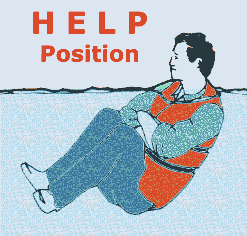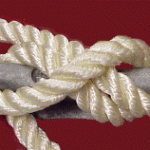Jan. 10, 5 a.m.: Physically fit, 25-year-old identical twins fall overboard. One is thrown over the side of his commercial fishing trawler in heavy seas off the coast of Newfoundland, and his brother loses his vessel to a tropical storm near St. Thomas. Both enter the water at the same time, a quarter of a world apart. Both are separated from their respective vessels, but one is fighting for his life in forty-degree water, and the other struggling with high waves in tropical water temperature.
Enter your game show host. “Who wants to be a Millionaire? The question: Which of the two brothers survives that entire day and night to be rescued the following morning by a passing freighter?” The brother off St. Thomas, you quickly surmise. “Is that your final answer?”
This is, of course, a fictitious scenario. And if taken to a happy conclusion, both brothers survive. How is that possible? Well, as long as it’s fictitious, I’ll take the liberty of putting the Newfoundland brother in a hooded immersible survival suit over his regular clothing, and his brother in a type I or III PFD–with no sharks in the area.
The real danger to persons in water for any period of time, of course, is hypothermia. Hypothermia is a condition arising from the extreme loss of body heat. In water, your body loses heat 25 times faster than in air of the same temperature. Remember, your normal body temperature is 98.6 degrees, so any water in which you boat is colder than your body. In a battle as to whether your body will warm the ocean or lake to its temperature vs. the water lowering your body temperature to it, the water will always win. It’s just a matter of how long it will take to do it. And your core body temperature doesn’t have to fall much before you’re in serious trouble.
There are several factors that affect survival time in the water.
- The water temperature. As you might guess, the colder the water, the faster the heat loss from your body.
- What you’re wearing. In descending order of giving you the most time to be rescued alive: a hooded survival suit; a hooded float coat with beavertail (groin protection); a hooded float jacket tied at the waist; a type I or type III PFD; a type II PFD; no PFD, but a jacket or coat; no PFD. (PFD’s are on this list for two reasons — heat loss control and flotation. Flotation is important to allow you to remain still, thus reducing heat loss generated through activities like treading water.) Which leads us to…
- What you’re doing. Activity in the water will produce more body heat, but also expel heat faster into the water. So the idea is to preserve your core body temperature (upper torso and head) while moving about as little as possible. Your body will create some activity on its own, without any voluntary intervention on your part. (Shivering is one of those involuntary functions that is intended to help you generate more heat, and it will be a natural part of your time in the water, at least during the earlier stages of your survival.)
- Body fat. Here’s one case where a little lard won’t hurt you. Distance swimmer Lynne Cox is able to maintain her body temperature in colder water primarily because, even though aerobically she has the capacity of a marathon runner, she weighs in at 209 and is only 5 foot 6 inches tall. An estimated 40 percent of her body weight is fat. Now, nobody is going to recommend that you add body fat in order to extend your survival time in the event you end up in cold water, but if you’ve already got a little insulation, give yourself a slight edge on the survival time scale.
- Your will to survive. There is growing evidence that this factor may be one of the strongest influences on your survival. It is well documented that depression lowers your core body temperature and reduces your will to live.
So, wouldn’t it be great if you knew in advance that you were going to be plunged into the water and have to extend your survival time. You’d probably prepare for it by building up some body fat, donning a survival suit over your non-absorbent clothing, practicing lying still in the water until help arrived, and making a list of good thoughts to keep your positive side busy during those long hours afloat. Of course it doesn’t work that way. But it doesn’t hurt to prepare for that possibility by considering in advance the type of waters in which you boat and the probability of a quick rescue. Only then can you fully prepare for the possibility that you or a member of your family or crew might someday be in a position of needing an edge to survive a brush with hypothermia.
Authors note: There has been much written about the relationship between alcohol and hypothermia. The conclusion agreed upon by most is that alcohol’s most obvious affect is that it dramatically increases your chances of being in the water in the first place.








